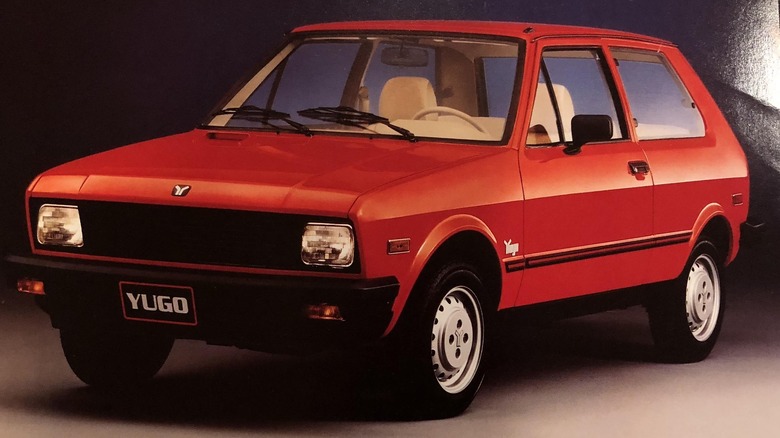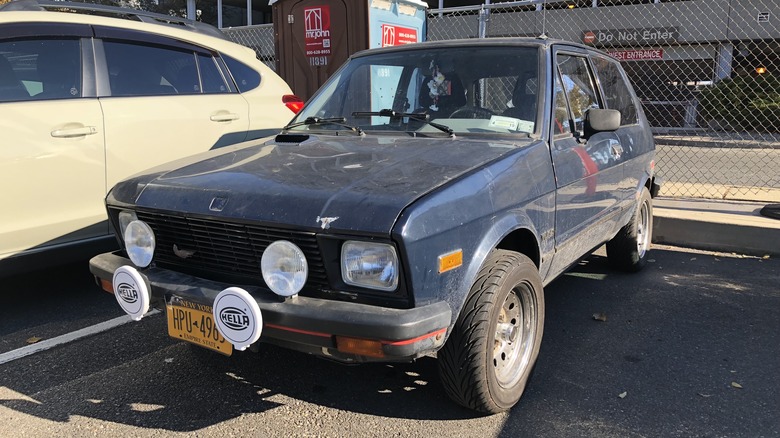Why The Yugo Is Considered The Worst Car Ever Sold In America
There are many reasons why a car could be considered "bad." Take a historically maligned vehicle like the Pontiac Aztek for example. It was unsuccessful not because it was a mechanical disaster as it was essentially just like any other General Motors minivan at the time. The Aztek fell on its face, because it looked like a crossover that was stung by a bee. Some vehicles, like the Lincoln Blackwood, fail because they are too expensive and offer very little over lower priced models in the same segment. The 11th generation Ford Thunderbird wasn't a terrible car in its own right, but it didn't do a fantastic job of living up to its storied namesake.
Rarely, however, a car comes along that fails to meet nearly every possible standard metric. One such car was the Yugo. Manufactured by Zastava in the Federal People's Republic of Yugoslavia, the Yugo was never really intended for American audiences and was a popular car when sold on its native soil (via Hemmings). Only when the Yugo made its way to American shores did the car completely fall apart (literally).
A bumper-to-bumper failure
The Yugo's disastrous migration to the United States in 1987 was an effort by Malcolm Bricklin, the man responsible for bringing Subaru to America years earlier. Priced at just $3,990 (a little over $10,000 in today's money), the Yugo was dirt cheap and offered enough features to make it favorable to a horse. However, it might lose out to a particularly nice golfcart or riding lawnmower. Air conditioning was not available, but an AM/FM radio fortunately was. That meant you could listen to the radio while sweating to death in traffic. According to Hemmings, the Yugo's model designation "GV" stood for "great value." In an amusing twist of fate, that also happens to be the name of Wal-Mart's store brand.
Mechanically, the car borrowed a lot from Fiat and the Yugo was initially powered by a 1.1-liter four cylinder that produced "some" horsepower, that was later "upgraded" to a 1.3-liter engine. According to Motorweek, it completed the quarter mile drag strip in just over 20 seconds, meaning that the poor car could only achieve appreciable speed if it was going downhill with a tail wind. The Yugo may have been extraordinarily cheap, but it was also offensively slow.
From the factory, Zastava offered a warranty that lasted exactly one year for the whole car and five years for the miserable drivetrain. That warranty was likely utilized quite a bit as the engine had an annoying habit of doing its best boat anchor impression when the timing belt inevitably shuffled off its mortal coil (via Hemmings).
The end of Yugoslavia and the Yugo
The Zastava may have been okay for the Yugoslavian market, but the car did not perform admirably on America's huge roads with its high-speed limits. A 1987 Chevrolet Suburban flying down the left lane of an American highway was practically a cruise ship going the speed of sound compared to the tiny Yugo. Even with the its shortcomings, Zastava managed to sell 141,000 Yugos on the U.S. market before disappearing back to Eastern Europe. Regulators stateside also didn't like the fact the Yugo was carbureted and demanded a recall based on environmental regulations (via Hemmings).
With the dissolution of Yugoslavia in the 1990s, it makes sense why the Yugo didn't have a long service life. The factory where it was assembled was bombed by NATO in 1999. According to NATO forces, Zastava was making rifles in the same factory as the car. Archival sources from Zastava prior to its sale to Fiat in 2008 deny any weapons manufacturing.

